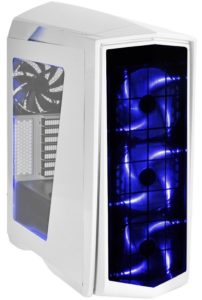SilverStone Primera PM01 ATX Case Review
Pros
Cons
Rating
Introduction
Here at The Tech Buyer’s Guru, we really like reviewing cases. That’s not because it’s easy or quick. In fact, case’s are one of the most time-consuming components to review, because to do it right, you actually have to build a whole new system! But we feel the selection of the right case is of critical importance to do-it-yourself PC builders, and the more cases we can get our hands on, the better advice we can give to our readers. We don’t have to test every case to know which features work and which don’t, but we certainly need to keep up on the latest approaches to case design.
And so we contacted SilverStone as soon as it announced the Primera PM01, because on paper (and in photos), we felt it had a lot of the modern features that would help it stand out from an endless array of copycat contenders. SilverStone was kind enough to provide a sample PM01 just as it was launched in North America, and we’ve been hard at work getting to know the case for the past month or so. Based on our experience building and extensively using a system in the case, we’re pretty sure we can give our readers the straight story on this very curvy case!
We’d like to extend a special thank you to SilverStone for providing a review sample of the SilverStone Primera PM01 White Case.
Description and Features
SilverStone markets the PM01 as being inspired by modern sports cars. Right off the bat, you’ll probably notice that the PM01 has a fairly aggressive profile, and much of what makes it interesting to look at does indeed borrow from the automobile world. Take, for example, the angular front mesh panel, the air scoops (non-functional, just like on many sports cars!), and the combination of hard-edged lines and graceful curves. SilverStone adds a feature you won’t find on many factory-spec sports cars but one that’s certainly popular with modders: ambient lighting. And while LED fans are nothing new, they look quite striking due to how deeply recessed they are in the front fascia, and they are complemented by well-placed LEDs around the case’s side window as well as its “hood”, for lack of a better term (calling it a top panel just wouldn’t do it justice!).
But all those curves and scoops come at a cost: they make the case extremely space inefficient. At 220mm wide, 571mm high, and 560mm deep, this case punches out to 70.3 liters, but its height and depth are way out of proportion to its decidedly-compact interior space. As we’ll discuss on the next page, the relatively narrow width, which hints at what were perhaps more modest origins, causes some serious cable management concerns that a typical 70L case wouldn’t have.
The fact that function follows form in regard to a few design flourishes doesn’t bother us too much, but there are several areas where SilverStone let a serious design win slip from its hands. Take, for example, the top air duct, which looks very stylish but could have been so much more functional. You have to remove it to mount a liquid CPU cooler, as we did, but the large interior volume taken up by the hood is rendered useless due to a lack of pass-through points for cables or tubes. It would have been so cool if SilverStone had designed this hood to accommodate dual 120mm fans, or even better, a 240mm or 280mm radiator, allowing builders to free up space inside the case. In the photo below, you can see how much potential this area might have had if SilverStone had taken the next step in its design of the PM01.
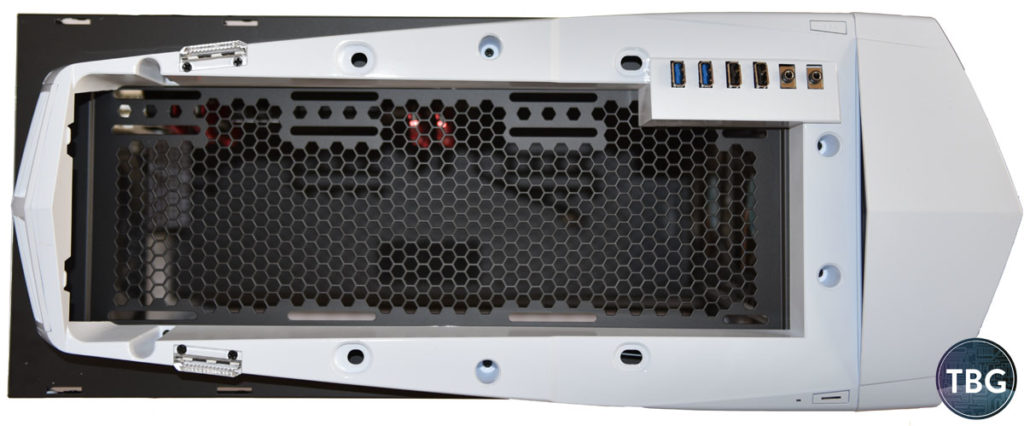
Another area where SilverStone might have added a few dollars to the bill of materials to make the case even better is in its 10-in-1 fan hub. SilverStone wisely added this hub to the back of the motherboard to allow users to utilize the four high-quality 140mm case fans included with the PM01. Attaching that many fans to the typical motherboard would quickly use up all available fan headers. But unfortunately, this fan hub is directly wired to a SATA power cable, with neither a user-selectable fan controller nor a PWM fan extension to piggy-back off of a motherboard’s fan controller. This is a big oversight as far as we’re concerned, as any fan connected to the hub will be forced to run at full speed. The fans SilverStone provides are thankfully rated only to 1050RPM, which means they are quiet even when maxed out. We applaud SilverStone for not going down the road so many cooler and case manufacturers do, equipping products with ultra-high-speed fans to “juice” the benchmarks at the expense of a tolerable user experience. That being said, these fans are dead silent when brought down to around 700RPM, and we only wish SilverStone hadn’t forced users to find a work-around to achieve this sonic bliss. By the way, while the PM01 has no external fan controller switch, SilverStone did include an LED switch on the top of the PM01. It allows the user to select high, low, “breathing,” or off, and while it works well, we wish it remembered our selection after shutting the system off, because, frankly, the LEDs are really bright at their default “high” setting.
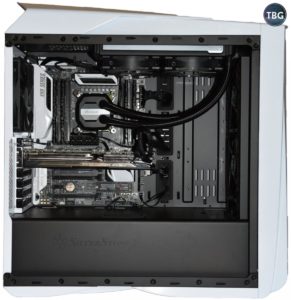
We’ll highlight some of the PM01’s other major features on the next page when we step through the assembly process, but first, let’s go over the components we used to put the case to the test:
- CPU: Intel Core i7-6900K
- Motherboard: Asus X99-Pro/USB 3.1
- Memory: G.Skill 4x8GB Ripjaws 4 DDR4-3000
- Video Card: EVGA GeForce GTX 980 Ti 6GB
- Solid-State Drive #1: Samsung 950 Pro 512GB M.2
- Solid-State Drive #2: Samsung 850 Evo 1TB
- Power Supply: EVGA Supernova 1000 PS
- CPU Cooler: Corsair Hydro H100i v2
- Operating System: Windows 10 Home
This is in fact the basis for our brand-new ultra-high-end benchmarking system, and we’ll be publishing a step-by-step assembly guide using many of the same components soon (although our venerable GTX 980 Ti will be replaced with a couple of GTX 1070s in SLI for a little added oomph!). SilverStone got lucky here, because we could have chosen a bunch of different cases for this build, but the PM01 came along at just the right time. Is it ideal for this setup? No, not quite, as we’ll discuss in this review, but then again, with a retail price of just $109.99, it’s relatively inexpensive, and probably would be a better fit for a slightly less ambitious system.
One last concern deserves mentioning at this point. The PM01 uses a sleek shroud to hide the power supply and its associated cables, as do most modern high-end cases. But unlike many of the cases we’ve tested recently, it doesn’t allow power supplies to be mounted with their fans pointed up, as there are no ventilation holes on top of the shroud. This isn’t ideal, but we could understand this choice based on the improved aesthetics a solid shroud provides…. if, that is, SilverStone didn’t go and really mess up the design of the bottom fascia of the case. You see, there’s essentially no open venting between the front and rear feet; rather, the case sits on a large molded plastic base. We’ve honestly never seen anything like this, and while it looks really cool, it most definitely doesn’t work really “cool.” We think SilverStone may need to redesign this in its next iteration, because it truly is a design flaw, from our point of view.
That being said, after making a few adjustments to work around its weaknesses, we’re confident this case will work just fine for this build. You can see our completed build above; we think you’ll agree it’s a pretty sleek setup! So let’s go ahead and step inside this case to see why, despite its imperfections, we still really like the Primera PM01!
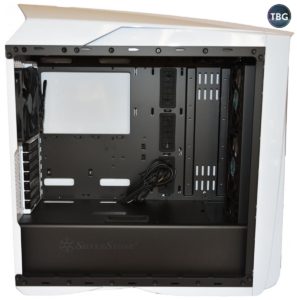
Assembly
As suggested on the previous page, SilverStone has worked hard to optimize airflow in this chassis. As can be seen in the interior shot shown here, the main motherboard compartment is as wide open as they come. Nothing’s going to stand in the way of air getting to your critical PC components! And as with many top-quality cases, you have nice rubber gromments protecting many of the cable management cutouts, along with a stylish matte black interior finish. And while we didn’t use it, we should note that there’s actually a “trap door” in the front of the power supply shroud, allowing you to mount 360mm CPU coolers vertically on the front panel.
Once we remove the right side panel and expose the inner workings of the case, we see how SilverStone has made the main compartment so clean: everything is tucked away tightly behind the motherboard tray. You have two vertical SSD mounts, three slide-out 3.5″drive trays, along with the power supply mounting area. You may wonder why we decided not to use the SSD mounts, instead affixing our Samsung 850 Evo to a 3.5″ tray. Well, as it turns out, the cable management area behind the motherboard tray is barely 1/4″ wide, meaning that the simple act of hooking up SATA power cables to vertically-mounted SSDs would make reattaching the side panel an exercise in frustration. Even without the SSDs mounted there, we really had to work hard to keep our 24-pin motherboard cable out of the way of the side panel. It’s over a 1/4″ thick, after all. On a positive note, the pre-installed cable ties are awesome, featuring an extra loop to make opening and closing the ties easier. It’s a bit hard to explain, but trust us, they work. Too bad there isn’t enough space between the motherboard tray and the side panel to actually route the motherboard’s power cable through those fasteners!
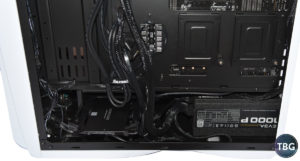
We have just a few other nitpicks that we think SilverStone should consider addressing to make the assembly process go more smoothly. First, we were surprised to find that only six motherboard standoffs were installed from the factory, despite the fact that standard high-end ATX motherboards require nine. Yes, ultra-narrow ATX boards require different standoff positioning, but we think SilverStone should assume that users of the PM01 have a high-end board to drop in their high-end case. Second, we’d really like to see captive screws on the side panels, a feature that’s made its way down to many midrange cases we’ve tested recently. Finally, SilverStone may wish to borrow a design element pioneered by its competitor Phanteks, which has also worked hard to break free from the pack when it comes to interior case design. The large open area behind the front fans could easily accommodate modular drive sleds, but instead SilverStone leaves this area almost completely unusable, equipping it only with mounts for the extremely uncommon liquid coolant reservoirs. Yes, the reservoirs used in custom cooling loops look really cool, but we sincerely doubt many buyers of the PM01 will choose to install one, if for no other reason than that the side panel window actually blocks this area from view!
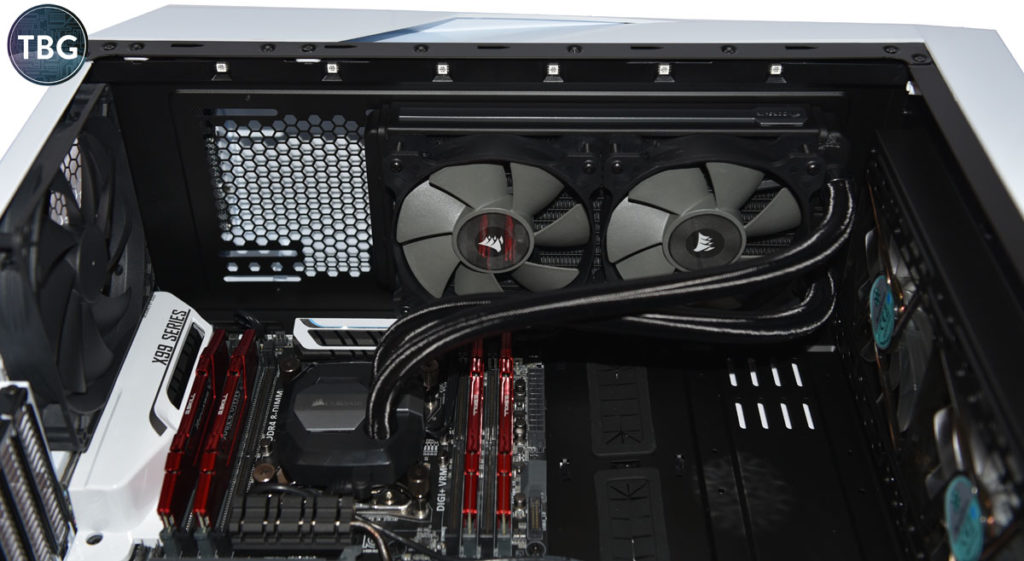
Once the motherboard was installed, it came time to mount our big 240mm liquid CPU cooler. As we mentioned on the previous page, the cooler and its fans must be mounted internally, even though you need to remove the top hood to secure them. And as it turned out, there was precious little clearance above our motherboard’s top heatsink once the radiator was installed, so little in fact that our 120mm fans touched it. We decided to mount the cooler towards the front of the chassis, because had we mounted it in the rear 240mm bracket, we would have lost all access to motherboard power connectors and fan headers. And unfortunately, we’re going to have to call SilverStone out here for a little bit of misleading marketing. The PM01 specifications, as shown on the SilverStone website, clearly state that the top panel can accommodate a 280mm cooler. Based on that specification, we had considered buying the Corsair Hydro H115i 280mm cooler specifically for this build, to replace the Hydro H100i v2 240mm cooler we already had on hand. Thank goodness we didn’t waste the money on that cooler, because no one is ever going to be installing a 280mm cooler on the top panel of the PM01. There isn’t the slightest chance you can get two 140mm fans and a radiator in there with a motherboard installed. It seems SilverStone forgot to include the space the motherboard takes up when it took its measurements! As an aside, you can mount a 280mm cooler to the front panel, but we view this an sub-optimal, as it means hot air will exhaust directly into the case.
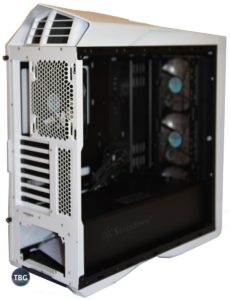
Performance
OK, so we had our issues with the build process, but how does this case perform? Well, in a word, it depends. The case has the potential to run louder than necessary, while also overheating the power supply. But that didn’t happen in our build. We re-routed all of our fan connectors from the included hub to our motherboard in order to gain fine-grained control over fan speeds, allowing the system to run whisper-quiet at idle. We also equipped the build with an exceptionally-efficient Platinum-rated power supply, which generated virtually no waste heat even when putting out 450W of power. As a result, the fan never spun up, indicating that even in the tight confines of the PSU shroud, it wasn’t overheating. Want to use a high-wattage, low-efficiency unit in this case? You better think twice!
As we mentioned above, we positioned our CPU cooler towards the front of the chassis due to it barely clearing our motherboard’s top edge. This had a positive effect on operating temperatures, as the CPU might as well have been sitting outside the case: the CPU cooler took in air directly from the front panel, and pushed it directly out the back of the top hood, which we’ve pictured here. While the case’s scoops are non-functional, its rear vent is most definitely working to full effect. In other words, no hot system air entered the cooler, and no CPU exhaust air entered the case. Sweet!
Note that the PM01 isn’t quite as quiet as its competitors using increasingly-popular solid front panels, but interior temperatures are so much lower when you don’t curtail airflow in that manner. We found that even when overclocked to 4GHz at 1.25V, our eight-core i7-6900K remained under 80°C with an AVX load, which is simply mind-blowing considering how much stress it’s under. We are of the opinion that enthusiasts running overclocked high-end builds are going to like the PM01’s balance of low-noise operation and extreme interior airflow. It really is quite impressive.
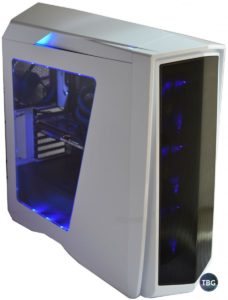
Conclusion
There’s just no other way to say this: the PM01 is about as close to perfection as you’ll find in any case near the $100 mark. It sports a cutting-edge exterior design along with a sleek approach to interior layout, eschewing the typical ghastly array of hard drive cages that plague most of its competitors. This in turn allows its front-mounted wall of 140mm fans to do their best work. Indeed, the PM01 hints at the future of case design, and it’s been a long time coming. You see, airflow has always played second fiddle to case “expandability,” in the form of a seemingly endless number of 3.5″ and 5.25″ drive mounts. In our opinion, it’s about time PC enthusiasts junk all their optical drives and low-capacity hard drives and become acquainted with a case based on a thoroughly-modern view of storage. You’ve got three 3.5″ bays and two 2.5″ bays, plus any M.2 slots your motherboard comes equipped with. In our opinion, that’s more than enough, and if you don’t agree, it’s probably time for you to start chucking all the 200GB hard drives you’ve been passing from system to system for the last ten years!
But as is often the case with its products, SilverStone lets lofty concepts get in the way of true ingenuity. From the impossibly-narrow cable management area, to the only semi-functional top hood, to the lack of fan controls, to the blocked power supply air intake, the PM01 is clearly a work in progress. Luckily, we know for a fact that SilverStone is always listening, and we have no doubt that in the near future, we’ll see a PM01-E that fixes all of these oversights while providing additional upgrades that we have yet to dream of. The letter “E” stands for evolution in SilverStone speak, and it’s a concept SilverStone takes to heart. That’s why we keep coming back to SilverStone cases. We have yet to find one that’s perfect, but every single SilverStone case we’ve reviewed pushes the boundaries of case design, and goodness knows someone has to do it. Thank you SilverStone for daring to think different!
As of our publication date, the SilverStone Primera PM01 is available in White with Blue LEDs for $109.99 shipped free from Amazon, which we’ve profiled here, as well as in Black with Red LEDs. If you’d like to build your own PC using the PM01, check out our Do-it-Yourself PC Buyer’s Guides for plenty of component options!


